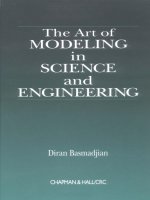MATHEMATICAL METHOD IN SCIENCE AND ENGINEERING Episode 3 docx
Bạn đang xem bản rút gọn của tài liệu. Xem và tải ngay bản đầy đủ của tài liệu tại đây (2.46 MB, 40 trang )
SPHERICAL HARMONICS
33
2
- -
w22
[-]
all,.
(I
-
m)!
(21
+
1)
(2.173)
Associated Legendre
Polynomials
Po"(.)
=
1
P;(Z)
=
(I
-x')~/'
=
sin8
Pi(z)
=
3z(1
z')~/'
=
3cosBsinB
P,"(z)
=
3(
1
-
z')
=
3 sin'
8
P,'(z)
=
-(52
-
1)(1-
z')'/'
=
-(5c0s26
-
1)sinB
P,"(z)
=
152(1
-z')
=
15cos8sin'B
Pi(.)
=
15(
1
-
z')~/'
=
15sin3
8.
3 3
2 2
2.5
SPHERICAL HARMONICS
We have seen that the solution
of
Equation (2.17) with respect to the inde
pendent variable
4
is given
as
(4)
=
Aeim4
+
Be-im@.
(2.174)
Imposing the periodic boundary condition
am(4
+
2~)
=
am(+),
it
is
seen
that the separation constant
m
has to take finteger values. However, in
Section 2.4 we have also seen that
m
must be restricted further to the integer
values
-1,
,
0,
,
1.
We can now define another complete and orthonormal
set
as
1
{am($)
=
-eim@}
,
m
=
-1,
,
0,
,
1.
(2.175)
6
This
set
satisfies the orthogonality relation
2T
Jd
d4amt
(4)*~(4)
=
fimmf.
(2.176)
We now combine the two sets
{am(4)}
and
{F;r"(8)}
to
define
a
new com-
plete and orthonormal
set
called the
spherical harmonics
as
21
+
1
(I
-
m)!
47r
(1
+m)!
elm+
P,"(cosB),
m
2
0.
(2.177)
34
LEGENDRE EQUATION AND POLYNOMIALS
In conformity with applications to quantum mechanics and atomic spec-
troscopy, we have introduced the factor
(-l)m.
It is also called the
Condon-
Shortley
phase.
The definition
of
spherical harmonics can easily
be
ex-
tended to the negative
m
values
as
Y-"(6,4)
=
(-1)mqm*(Q,4),
m
2
0.
(2.178)
The orthogonality relation of
Ym(8,
4)
is given
as
Since they
also
form
a
complete set, any sufficiently well-behaved and
at
least
piecewise continuous function
g(B,$)
can
be
expressed in terms of
qm(8,
4)
as
1=0
m=-1
where the expansion coefficients Akare given
as
(2.180)
(2.181)
Looking back
at
Equation (2.13), we
see
that the spherical harmonics sat-
isfy the differential equation
(2.182)
If we rewrite this equation
as
the left-hand side is nothing but the square of the angular momentum operator
(aside from
a
factor
of
ti)
in quantum mechanics, which is given
as
(2.184)
In quantum mechanics the fact that the separation constant
X
is restricted
to
integer values means that the magnitude of the angular momentum is
SPHERlCAL HARMONlCS
35
quantized.
From
Equation
(2.183)
it is seen that the spherical harmonics are
also the eigenfunctions
of
the
3'
operator.
Spherical
Harmonics
q"(8,
$)
36
LEGENDRE EQUATION AND POLYNOMIALS
1=3
Problems
2.1
tial equations:
i) Laguerre equation:
Locate and classify the singular points
of
each
of
the following differen-
ii)
Harmonic oscillator equation:
d2Q&
(.)
+
(.
-
x2)
IFE
(X)
=
0
dx2
iii) Bessel equation:
2JL(X)
+
ZJL(X)
+
(2
-
rn2)Jm(X)
=
0
iv)
d2Y
dY
2
(x4
-
2X3
+
X2)-
+
(.
-
1)
-
+
2x
=
0
dx2
dx
PROBLEMS
37
vi) Chebyshev equation:
&Y
dY
-
-
2-
dx +n2y
=
0
vii) Gegenbauer equation:
gc;
dCX (x)
dx2 dx
(1-2)-
-(2X+l)x-” ++(n+2X)C~(x)=O
viii) Hypergeometric equation:
d2y(z)
+
[c
-
(a
+
b
+
1)x]- dy(x)
-
uby(x)
=
0
z-
d2y(z)
+
[c
-
21-
-
.y(z)
=
0
dx
2(1-x)-
dx2
ix) Confluent Hypergeometric equation:
dYk)
dz2
dz
2.2
find
solutions about
x
=
0:
For
the following differential equations use the Frobenius method to
i>
2x
3
-++x2-++3y=O d2Y dY
dx2
dx
ii)
iii)
iv)
v)
vi)
3
d2Y
2
dY
8
x -++x -+(x3+-x)y=O 9
dx2 dx
3
d2Y
2
dY 3
x -+fx -+(x3+-x)y=O
dx2 dx
4
2d2Y dY
x
-
+
3x-
+
(22
+
1)y
=
0
dx2 dx
&Y
ZdY
x3-
+
2
-
+
(8z3
-
9x)y
=
0
dx2 dx
2
2d2Y -+x-+x2y=o dY
dx2 dx
38
LEGENDRE EQUATION AND POLYNOMIALS
vii)
d2Y
dY
Z-
+
(1
-I.)
-
+4y
=
0
dX2
dx
viii)
3
d2Y
2
dY
2%
-
+
52
-
+
(x3
-
2x)y
=
0
dx2
dx
2.3
Find finite solutions of the equation
d2Y
dY
(1
-
2)-
-
2-
+
n2y
=
0
dx2
dx
in the interval
3:
E
[-1,1]
for
n
=
integer.
2.4
Consider
a
spherical conductor with radius
a,
with the upper hemisphere
held at potential
Vo
and the lower hemisphere held
at
potential
-Vo,
which
are
connected by an insulator at the center. Show that the electric potential
inside the sphere is given
as
2.5
solutions of
Using the Frobenius method, show that the two linearly independent
R
=
0,
are given
as
2.6
The amplitude of
a
scattered wave is given as
00
f(0)
=
yC(21+
l)(ei6[
sinGl)e(cosB),
1
=o
where
B
is the scattering angle,
1
is the angular momentum, and
61
is
the
phase shift caused by the central potential causing the scattering. If the total
scattering cross section is
PROBLEMS
39
show that
2.7
Prove the following recursion relations:
4
(z)
=
P;+l
(z)
+
(x)
-
2x4'
(.>
P(,l
(z)
-
xP(
(z)
=
(1
+
l)q
(x)
2.8
Use the Rodriguez formula
to
prove
P;
(z)
=
zP;-,
(x)
+
14-1
(z)
where
1
=
1,2,
.
2.9
Show that the Legendre polynomials satisfy the following relations:
9
d
-
dx
[(l
-
z2)P/(iC)]
+
1(1+
1)9(x)
=
0
2.10
Derive the normalization constant,
Ni,
in the orthogonality relation
1
s_,
P1)
(z)
A
(x)
&E
=
"b
of
the Legendre polynomials by using the generating function.
2.11
Show the integral
40
LEGENDRE EQUATION AND POLYNOMIALS
where
(1
-
n)
=
(even integer]
.
2.12
are given
as
Show that the associated Legendre polynomials with negative
m
values
(I
-
m)!
(1
+
m)!
PFrn(Z)
=
(-1)rn-
P;"(z),
m
2
0.
2.13
in the interval
[-1,1].
2.14
A
metal sphere is cut into sections that are separated by
a
very thin
insulating material. One section extending from
6
=
0
to
8
=
8,
at potential
Vo
and the second section extending from
6
=
60
to
8
=
7r
is
grounded. Find
the electrostatic potential outside the sphere.
2.15
Expand the Dirac delta function in
a
series
of
Legendre polynomials
The equation for the surface of
a
liquid drop (nucleus) is given by
22 22 24
T
=a
(I+E~-+E~-),
T2
r4
where
2,
€2,
and
€4
are given constants. Express this in terms
of
the Legendre
polynomials
as
2.16
can
be
expressed in terms
of
the Legendre polynomials
as
Show that the inverse distance between two points in three dimensions
1
1
where
r<
and
r,
denote the lesser and the greater of
r
and
r',
respectively.
2.17
Evaluate the sum
&+1
03
s
=
c
-fi(Z).
l=O
1+1
Hint:
Try
using the generating function for the Legendre polynomials.
2.18
Wronskian
If two solutions
yl(z)
and
y2(z)
are
linearly dependent, then their
W[Yl(Z),Y2(Z)I
=
Yl(Z)Y2Z)
-
d(Z)Y2(Z)
PROBLEMS
41
vanishes identically. What
is
the Wronskian of two solutions of the Legendre
equation?
2.19
The Jacobi polynomials Pp'b)(~~~8), where
n
=
positive integer and
a,
b
are
arbitrary real numbers,
are
defined by the Rodriguez formula
d"
2"n!(l
-
x)"(l+
x)b
dx"
P b'(x)
=
(-1"
-
[(
1
-
,)"+a(
1
+
Z)"+b]
,
1x1
<
1.
Show that the polynomial can
be
expanded
as
n
P27b)(~~~6)
=
A(n,
a,
b,
k)
ks0
Determine the coefficients
A(n,
a,
b,
k)
for
the special case, where
a
and
b
are
both integers.
2.20
Find solutions
of
the differential equation
d2Y
2~(x
-
1)-
+
(10~
-
dx2 dx
satisfying the condition
y(x)
=
finite
in the entire interval
z
E
[0,1].
Write the solution explicitly
for
the third
lowest value
of
A.
This Page Intentionally Left Blank
3
LAGUERRE
POL
YNOMIA
LS
For the central force problems, solutions
of
the time-independent Schrodinger
equation can be separated
as
R(T)Y,YQ,
41,
(3.1)
where the angular
part
is the spherical harmonics and the radial part comes
from the solutions
of
the differential equation
where
2m
h2
it2
=
-
[E
-
v
(r)]
If
we substitute
(3.3)
the differential equation
to
be solved
for
uE,l(r)
becomes
To
indicate that the solutions depend on the energy and the angular momen-
tum values, we have written
uE,1
(r)-
43
44
LAGUERRE
POLYNOMIALS
For
singleelectron atom models potential energy is given
as
Coulonib's law:
Ze2
r
V(r)
=
,
(3.5)
where
Z
is the atomic number and
e
is the electron's charge.
A
series solution
in Equation
(3.4)
yields a threeterm recursion relation.
To
get a two-term
recursion relation we investigate the behavior of the differential equation near
the end points,
0
and
CQ,
which suggests that
we
try a solution
of
the form
where we have defined
a
dimensionless variable
p
=
rdm.
electrons in
an
atom are bounded, their energy values are negative.
simplify the differential equation for
w(p)
further by the definitions
and
to write
d2W
dw
PT
+
2(1
+
1
-
P)-
+
[Po
-
2(1+
l)]w(p)
=
0.
dP
dP
We now try a series solution
(3.6)
Because
We can
(3.7)
(3.10)
k=O
which gives us a two-term recursion relation
ak+l
UE
,
goes
as
L;
In the limit as
k
+
00
the ratio of two successive terms,
-
k
(3.11)
2
hence the infinite series in Equation
(3.10)
diverges as
e2P,
which also implies
that
RE,l(r)
diverges as
r1eTm.
Since
I
(r)q"(e,
'P)
l2
(3.12)
represents the probability density of the electron, for physically acceptable
solutions
RE,l(r)
must be finite everywhere. In particular, as
r
+
CQ
it should
LAGUERRE EQUATION AND POLYNOMIALS
45
go to zero. Hence for
a
finite solution in the interval
[O,m],
we
terminate the
series
[Eq.
(3.10)]
by restricting
po
(energy) to the values
po
=
2(N
+
1
+
l),
N
=
0,
1,2,
.
(3.13)
Since
1
takes integer values, we introduce
a
new quantum number,
n,
and
write the energy levels of
a
singleelectron atom
as
Z2me4
2fi2n2
'
n
=
1,2,
,
En
=
(3.14)
which are nothing but the Bohr energy levels.
equation
to
be
solved for
w(p)
as
Substituting Equation
(3.13)
in Equation
(3.9)
we obtain the differential
(3.15)
solutions of which can be expressed in term of the
associated
Laguerre
polynomials.
3.1
LAGUERRE EQUATION AND POLYNOMIALS
The Laguerre equation is defined
as
d2Y
dY
~2
dx
+
(1
-x)
-
dx +ny
=
0,
(3.16)
where
n
is
a
constant. Using the Frobenius method, we substitute
a
series
solution about the regular singular point
x
=
0
as
r=O
and obtain
a
two-term recursion relation
(S
+
T
-
n)
(s+r+q2'
ar+l
=
a,
In this case the indicia1 equation has
a
double root,
s
=
0,
where the two linearly independent solutions are given
as
(3.17)
(3.18)
(3.19)
(3.20)
46
LAGUERRE POLYNOMIALS
The second solution diverges logarithmically
as
x
+
0.
Hence for finite
s-
lutions everywhere we keep only the first solution,
y
(z,
0)
which has the
recursion relation
(3.21)
This gives us the infinite series solution as
,y-+
n(n 1)x2+ +
(-l)?
n (n
-
1)
(n
-
T
+
1)
y(2)=ao
1 +
{
l2
(2!)2 (r!l2
(3.22)
From the recursion relation [Eq.
(3.21)],
it
is
seen that in the limit
as
T
+
co
the ratio
of
two successive terms has the limit
ar+l/ar
f
l/r;
hence this
series
diverges
as
e"
for large
x.
We now restrict
n
to integer values to obtain
finite polynomial solutions
as
n
n(n-
l) (n-r+
1)
X*
(?-!)2
y
(x)
=
aoz
r=O
n
n!xr
=
a0C
r=O
(n
-
T)! (T!)2.
(3.23)
Laguerre polynomials are defined by setting
a0
=
1
in Equation
(3.23)
as
3.2
OTHER DEFINITIONS OF LAGUERRE POLYNOMIALS
3.2.1
The generating function
of
the Laguerre polynomials is defined
as
Generating Function
of
Laguerre Polynomials
-xt
(3.24)
(3.25)
To
see
that this gives the same polynomials
as
Equation
(3.24),
we expand
the left-hand side
as
power series:
-xt
1-
1
"1
-,(I
-4
=
-
(1-t)
(1
-
t)
r=o
c,
[-&Ir
zrtr
r=O
(3.26)
OTHER
D€F/N/T/ONS
OF
LAGUERRE
POLYNOMIALS
47
Using the binomial formula
1
(r
+
1)
(r
+
2)t2
+.
.
.
=
l+(r+l)t+
2!
(1
-
ty+'
OC)
(r
+
s)!
=cr
tS,
s=o
(3.27)
Equation
(3.26)
becomes
Defining
a
new dummy variable
as
n=r+s,
we now write
(3.29)
and compare equal powers
of
t.
Since
s=n-r>O,
r
5
n;
thus
we
obtain the Laguerre polynomials
L,
(x)
as
(3.31)
(3.32)
3.2.2
Another definition
of
the Laguerre polynomials is given in terms
of
the
Ro-
driguez formula:
Rodriguez
Formula
for
the Laguerre Polynomials
(3.33)
To
show
the equivalence
of
this formula with the other definitions we use the
Leibniz formula
(3.34)
to
write
n
n!
dnPrxn dre-"
(3.35)
ex
dn
ex
(xne-x
n!
dxn
)=,!C
(n-r)!T!
dxn-r
dxr
.
r=O
48
LAGUERRE POLYNOMIALS
We now use
dPXq
dxp
-
q(q
-
I).
. .
(q
-p+
1)xq-p
to obtain
n!
n!
n.
(n
-
r)!r!
r!
n!xT
-zT
epx
ex
dn
ex
n!
dxn
(xne-")
=
-i-c
r=O
n
=
c
2
r=O
(r!)
(n
-r)!
(3.36)
(3.37)
=
L,
(x).
3.3
ORTHOGONALITY
OF
LAGUERRE POLYNOMIALS
To
show that the Laguerre polynomials form an orthogonal set, we evaluate
the integral
(3.38)
Using the generating function definition of the Laguerre polynomials we write
03
=
ELn
(z)
tn
n=O
1-t
and
OL)
xs
1
=
ELm
(z)
sm.
n=O
1-s
(3.39)
(3.40)
We first multiply Equations
(3.39)
and
(3.40)
and then the result with
ep"
to
write
(3.41)
ORTHOGONALiTY
OF
LAGUERRE POLYNOMlALS
49
Interchanging the integral and the summation signs and integrating with
re-
spect
to
x
gives
us
2
[~We~xLn(x)Lm(x)dx
1
tnsm
n,m=O
It is now seen that the value of the integral in Equation
(3.38)
can
be
obtained
by expanding
in powers
of
t
and
s
and then by comparing the equal powers
of
tnsm
with
the left-hand side of Equation
(3.42).
If
we write
I
as
t
S
I=
JWexp
{
-x
(1
+
-
1-t
+
-)}
1-s
dx,
(3.44)
(1-9(1-4
0
the integral can
be
taken to yield
00
-exp
{
-x
(1
+
A
+
e)}
I=
1
(3.45)
r
1
1
1
-
st
-
W
=
Csntn.
n=O
(3.46)
(3.47)
(3.48)
This leads us to the orthogonality relation
for
the Laguerre polynomials
as
e-"Ln (x)
L,
(x) dx
=
6
nm.
Compared with the Legendre polynomials, we say that the Laguerre polyno-
mials are orthogonal with respect to the weight function
e-".
50
LAGUERRE POLYNOMIALS
3.4 OTHER PROPERTIES
OF
LAGUERRE POLYNOMIALS
3.4.1 Recursion Relations
Using the method we have
used
for the Legendre polynomials, we can obtain
two recursion relations for the Laguerre polynomials. We first differentiate
the generating function with respect to
t
to obtain
(n+I)L,+1
(z)
=(2n+l-z)Ln(z) Ln-1(z).
(3.49)
Differentiating the generating function with respect
to
x
gives
us
the second
recursion relation
zLL
(5)
=
nLn
(z)
-
nL-1
(z)
Another useful recursion relation
is
given
as
11-1
r=O
Laguerre
Polynomials
Lo
(x)
=
1
L1
(x)
=
L2
(XI
=
-x
+
1
(1/3!)
(-x3
+
9z2
-
18%
+6)
(1/4!)
(z4
-
16x3
+
722’
-
962
+
24)
(1/2!)
(9
-
42
+
2)
L3
(x)
=
L4
(x)
=
L5(x)
=
(1/5!)
(-z5
+
25x4
-
200x3
+
600~’
-
600x
+
120)
3.4.2
Taking
x
=
0
in the generating function
we
find
Special Values
of
Laguerre Polynomials
1
1-t
00
ELn
(0)t”
=
-
n=O
00
=
Ct’”
n=O
This gives
us
the special value
L,
(0)
=
1.
(3.50)
(3.51)
(3.52)
(3.53)
(3.54)
(3.55)
Another special value is obtained by writing the Laguerre equation at
x
=
0
as
ASSOCIATED LAGUERRE EQUATION AND POLYNOMIALS
51
which gives
Lk
(0)
=
-n.
(3.57)
3.5
ASSOCIATED LAGUERRE EQUATION AND POLYNOMIALS
The associated Laguerre equation
is
given as
d2Y
dY
x-
+
(k
+
1
-x)-
+ny
=
0,
dx2 dx
(3.58)
which reduces to the Laguerre equation for
k
=
0.
Solution of Equation
(3.58)
can be found by the following theorem:
Theorem:
Let
Z
(x)
be
a
solution of the Laguerre equation of order
(n
+
k)
,
dkZ
(x)
dxk
then
-
satisfies the associated Laguerre equation.
Proof:
We write the Laguerre equation of order
(n
+
k)
as
d2Z
dZ
dx2 dx
5-
+
(1
-x)
-
+
(n+
k)Z(x)
=
0.
(3.59)
Using the Leibniz formula [Eq.
(3.34)],
k-fold differentiation of Equation
(3.59)
gives
dki2Z dk++'z dk+'Z dkZ dkZ
dx dxk
dxk++l
+k(-1)
+
(n+k)
-
=
0.
X-+k-
dxk+2 &k+l
+
-
-
(3.60)
Rearranging this, we obtain the desired result as
=O.
(3.61)
Using the definition of the Laguerre polynomials [Eq.
(3.32)],
we can now
write the associated Laguerre polynomials as
dk
(n
+
k)!xr
L;
(x)
=
(-1)
7-
(-1y
(3.62)
dx
r=O
(n
+
k
-
T)!
(T!)2.
Since k-fold differentiation
of
x'
is going to give zeroes for the
T
<
k
values,
we can write
dk
n+k
(n
+
k)!x'
dxk
r=k
(n+k-T)!(T!)2'
L;
(x)
=
(-1)
-x
(-1y
(3.63)
52
LAGUERRE
POLYNOMIALS
(3.64)
(n
+
k)!
r!
xr k
n+k
L;
(2)
=
(-1y
c
(-1y
r=k
(n
+
IC
-
r)! (r!)2
(r
-
k)!
Defining a new dummy variable
s
as
s=r-k,
(3.65)
we
find the final form of the associated Laguerre polynomials
as
(n
+
k)!x"
(n
-
s)!
(k
+
s)!s!.
n
L;
(x)
=
c
(-1y
s=o
(3.66)
3.6
PROPERTIES
OF
ASSOCIATED LAGUERRE POLYNOMIALS
3.6.1 Generating Function
The generating function of the associated Laguerre polynomials is
defined
as
To prove this we write the generating function of the Laguerre polynomials
as
r
xt
1
M
(1
-
t)"l
n=O
(3.68)
which
gives
us
This can also be written as
kexp
[-*I
O3
dk
-t)
=
csLn+k
(x)tn+k.
(3.70)
[&I
(I-t)
n=O
We
now use the relation
(3.71)
PROBLEMS
53
to
write
00
zt
=
c
(-l)k
Lk
(z)tn+k,
(3.72)
tk
(1
-t)"+l
exp
[-m]
n=O
which
leads
us
to
the desired result
M
=
EL:
(z)t".
(1
-
t)k+'
n=O
(3.73)
3.6.2
Rodriguez Formula and
Orthogonality
The Rodriguez formula
for
the associated Laguerre polynomials is given
as
[e-xzn+k].
eXxPk
6"
n!
dxn
Lk
(z)
=
Their orthogonality relation is:
where the weight function
is
given
as
(e-"zk).
(3.74)
(3.75)
(3.76)
3.6.3
Recursion Relations
Some frequentIy used recursion relations
of
the associated Laguerre polyno-
mials are given
as
(72
+
1)
Lk+]
(z)
=
(2n
+
k
+
1
-
z)
L:
(z)
-
(n
+
k)Lk-,
(z)
(3.77)
d
x-L:(z)= dx
nL:(z)-(n+k)L:_l(z) (3.78)
(3.79)
k
(z)
-I-
L:-I
(z)
=
Lk
(z).
Problems
3.1
is written
as
We have seen that the Schrodinger equation
for
a
single-electron atom
54
LAGUERRE
POLYNOMIALS
i) Without any substitutions, convince yourself that the above equation gives
a
three-term recursion relation and then derive the substitution
which
leads
to
a
differential equation with
a
two-term recursion relation for
w(p).
We have defined
a
dimensionless variable
p
=
rdm.
Hint:
Study the asymptotic forms and the solutions of the differential equation
at
the end points
of
the interval
[0,
m].
ii) Show that the differential equation for
w(p)
has the recursion relation
ak+l
-
2(kfI+1)-pO
ak
(kf
1)(k+21+2)'
where
Po
=
/&
2m
Ze2
3.2
Derive the recursion relations
zLL
(z)
=
nLn
(z)
-
nLn-l
(z),
and
n-
I
3.3
relation
Show that the associated Laguerre polynomials satisfy the orthogonality
(n
+
k)!
n!
(z)
LL
(z)
dx
=
___
Snm.
3.4
the spherical harmonics and the associated Laguerre polynomials.
3.5
Using the generating function
Write the normalized wave function
of
the hydrogen atom in terms of
PROBLEMS
55
derive the Rodriguez formula for Lk
(x)
.
3.6
polynomials.
3.7
Show the special value
Find the expansion of exp(-kx) in terms
of
the associated Laguerre
(n
+
k)!
n!k!
Lk(0)
=
~
for the associated Laguerre polynomials.
3.8
i) Using the Frobenius method, find a series solution about x
=
0
to the
differential equation
&C
dC
X
dx2
dx
4
2-
+-+(A-
-)C=
0,
x
€
[O,m].
ii)
Show that solutions regular in the entire interval
[0,
m]
must be of the form
c,(x)
=
e-z/2T,n(x),
with
X
=
n+1/2,
n
=
0,1,2,
,
where
En(.)
satisfies the differential equation
d2En
dz,
dx2 dx
x-
+
(1
-x)
-
+nEn
=
0.
iii) With the integration constant
a,
=
(-l),,
find the general expression for the coefficients
a,-j
of
z,(z).
iv) Show that this polynomial can also be defined by the generating function
exP[-&]
03
-
T
(x,
t)
=
=
c
Ln
tn
n!
(1-t)
-0
or
the Rodriguez formula
v) Derive two recursion relations connecting
Ln+1, Ln and
In-1
and
-I
L, with L,, L,-1.
56
LAGUERRE POLYNOMIALS
vi) Show that
Cn(x)
form an orthogonal set, that is,
and calculate the integral
Note: Some
books
use
Zrn
for
their definition
of
Laguerre polynomials.
3.9
Starting with the generating function definition
-xt
derive the Rodriguez formula
ex
dn
L,
(x)
=
(xnepz)
n!
dxn
for the Laguerre polynomials.
3.10
Using the series definition
of
the Laguerre polynomials, show that
LL(0)
=
-n,
1
Ll(O)
=
-n(n
-
1).
2
3.11
the three-dimensional harmonic oscillator is given
as
In quantum mechanics the radial
part
of
Schriidinger’s equation
for
+
E-x
&R(x) 2dR(x)
dx2 x dx
+
(
where
x
and
t
are defined in terms
of
the radial distance
r
and the energy
E
as
r
E
x=-
and
E=
-
Ifi
hw/2’
limw
1
takes the integer values
1
=
0,1,2
.
Show that the solutions
of
this equation
can
be
expressed in terms
of
the associated Laguerre polynomials
of
argument
22.
HERMITE
POL
YNOMIA
LS
The operator form of the time-independent Schriidinger equation is given
as
H@(T)=E@(T),
(4.1)
where
@(?)
is
the wave function,
H
is
the Hamiltonian operator, and
E
stands for the energy eigenvalues.
H
is usually obtained from the classi-
cal Hamiltonian by replacing
33''
(position) and (momentum) with their
operator counterparts:
Z-Z,
(4.2)
For
the one-dimensional harmonic oscillator, the Hamiltonian operator is
ob-
tained from the classical Hamiltonian
p2
mdx2
H=-
+-
2m 2
as
fi2
d2
mu2$
H(z)
=
+
-
2m
dx2
2
This leads us to the following Schrodinger equation:
d2@(x)
2m
(
dx2
h2
mu22x2)
\k
(z)
=
0.
+-
E
(4.3)
(4.4)
(4.5)
57









